Njase Joel, Simon Tembo
School of Engineering, University of Zambia, Lusaka, Zambia
Correspondence to: Njase Joel, School of Engineering, University of Zambia, Lusaka, Zambia.
| Email: |  |
Copyright © 2016 Scientific & Academic Publishing. All Rights Reserved.
This work is licensed under the Creative Commons Attribution International License (CC BY).
http://creativecommons.org/licenses/by/4.0/

Abstract
The recent past has witnessed extensive expansion in broadband networks and mobile technology, resulting in an unmatched degree of connectivity for ordinary citizens. However, the electronic collection, storage and sharing of complaints and information between public and the Police is still a major challenge in Zambia. In this study a mix of qualitative and engineering research was conducted through analysis of data obtained from unstructured interviews, observations and focus group guided by initial conceptual literature review. The research revealed that, there was no effective inter-operable communication channel between the Police and the citizens for sharing information, no specific policing strategy to optimize use of technology to enhance cooperation, and lack of institutional capacity to deal with matters of change management in digitalization process of the Zambia police systems and procedures. Therefore; to provide a cost effective communication channel, a generic text e-messaging application was designed using unified modeling language (UML) and then developed using object oriented language namely Java. To optimize use of existing public ICT and Telecommunication infrastructure, concepts on cloud computing, Open Service Architecture (OSA) and Intelligent Network (IN) were utilized through key technological features of divorced or independent business service logic from Network Control in respect to telecommunication infrastructure. Lastly, recommendations on factors that confront e-Policing adoption and implementation are discussed. Therefore, accessibility to police service and other factors such a building services around citizen choices, provision for social inclusion, and making better use of information from a centralized database system the way forward in Zambia.
Keywords:
Electronic policing, Policing strategies, Information sharing, Cloud computing, OSA, Generic application
Cite this paper: Njase Joel, Simon Tembo, E-Policing as a Service: The Way Forward in Zambia, Science and Technology, Vol. 6 No. 2, 2016, pp. 45-58. doi: 10.5923/j.scit.20160602.03.
1. Introduction
E-Policing as a service (e-PaaS) is specialized electronic service application for virtual Policing. It strikes a balance on cloud computing concept for everything as a Service (XaaS) and applied policing strategies in matters of public safety. Therefore, choice of technology, cost and infrastructure needed for information sharing was realized through e-Policing as a Service by integrating middleware technologies in a customized application especially under Intelligent Networks (IN). To appreciate this concept, understanding what e- Policing means was very important.Electronic policing is the use of Information Communication Technology (ICT’s) in police work to improve effectiveness and efficiency, supporting front-line officers and assisting in local problem-solving initiative to reduce crime and reassure public (Boondao and Tripathi, 2007). The accelerated development in Information Communication Technology (ICT’s) and Telecommunication services has brought numerous benefits in e-Health, e-Commerce, e-Education and e-Government. Accordingly, three specific areas of e-government can be identified (Marchionini et al., 2003): access to information, transaction service and citizen participation. Notwithstanding; how can citizens access information, conduct transaction service and participate, with low interest penetration of 15.4 percent in Zambia (www.trading economics .org) especially in matters of public safety. In contrast; mobile technology penetration is now 77 percent according to Zambia Information Communication and Technology Authority (ZICTA), but has equally not witnessed increased information sharing and inter-networking between Police and the Public. Further, existing different platforms and infrastructure between the public service providers and the Zambia Police communication infrastructure has equally resulted in lack of inter-operable communication channel.This is where electronic Policing as a Service plays a pivotal role in providing platform for the Public to engage in matters of Public Security. According to (Ashby and Longley, 2005) technology is currently used to support policing in several ways, such as database systems to record crime details and geographic information systems to profile the characteristics of local policing environment, crime profiles and police performance to provide increased intelligence, especially when it comes to Public security through virtual policing. Without the cooperation of the Public, policing becomes very difficult to implement and at the core of this cooperation demands information and the sharing of information for effective law enforcement (Le Beuf 2003). In their research (Liu and Hu, 2005) stated that in order to have improved accessibility to police service and other factors critical for e-policing must include:1) Building services around citizen choices,2) Proving for social inclusion, and 3) Making better use of information The aforementioned critical factors provide necessary requirements specification for e-Policing as a Service in our research.
1.1. Value and Definition
According to (LeBeuf, 2006) E-policing is electronic collection, storage and sharing of complaints and information from citizens.
1.2. Statement of Problem
The recent past (Perlman, 2012) has witnessed extensive expansion in broadband networks and mobile technology, affording ordinary citizens an unmatched level of connectivity. However, the electronic collection, storage and sharing of complaints and information between citizens and the Police is still a major challenge in Zambia.
1.3. Objective
To enhance electronic collection, storage and information sharing between Zambia Police and the Public, in order to improve efficiency and cooperation. Specific objectives include:1) To develop a generic e-messaging application using object oriented language (Java),2) To provide centralized management system on information sharing, and3) To provide best fit technologies to optimize Policing strategies and existing ICT/Telecommunication Public infrastructure in information sharing.
1.4. Research Questions
1) How can platform independent system be developed to link Police and the Public?2) How can ICT’s improve information management and what issues confront their adoption and implementation in Public safety?3) What cost effective technologies can be applied to optimize existing ICT/Telecommunication Public Infrastructure to enhance Public Safety?
1.5. Justification
The research has resulted in a generic e-messaging application to bridge the gap between the Zambia Police and the Public in information sharing. Additionally, a choice of multi-channel on e-Policing service, using mobile technology especially for those who cannot afford internet services will be realized.
2. Literature Review
The literature deals with a number of arguments on e-policing, adoption, implementation, and the way forward. Further, it includes how e-government programmes relate to e-policing in general.
2.1. E-Government Conceptual Frame Work
The United Nation’s guiding principles for crime prevention and Criminal Justice in the context of Development and a New International Economic order urge that “Community participation in all phases of crime prevention and criminal justice should be promoted and strengthened” (Viena. United Nations Office on Drugs and Crime, 2006). Further, the United Nation’s Code of conduct for law Enforcement official states “every law enforcement agency should be representative of, and responsive and accountable to, the community as a whole”. The later demonstrates extent to which the Public influence matters of policing activities. According to (Liu and Hu, 2005) the working group on E-Government in the developing world, under auspice of the Pacific Council on International Policy, listed the following as broad categories of the goals for e-government (PCIP, 2002):1) Improving services to citizens,2) Improving the productivity (and efficiency) of government agencies,3) Strengthening the legal system and law enforcement,4) promoting priority economic sectors,5) Improving the quality of life for disadvantaged communities, and6) Strengthening good governance and broadening public participation.Therefore, a number of these goals can effectively be applied to e-policing in Zambia and applying numerous features of local e-government as building block for service delivery, gives appropriate electronic services 24 hours a day, 7 days a week (Liu and Hu, 2005). The changing paradigm of law enforcement demands a parallel development in applied policing strategies in combating crime. “Policing is most obvious and apparent aspect of criminal justice system and a well-regarded police service is a prerequisite for the positive perception of justice” (Viena. United Nations Office on Drugs and Crime, 2006). The Zambian government through its ministries and departments has established websites to enhance service delivery to the public. Subsequently, a Police website was developed and launched on 14/01/2015. The purpose is to improve service delivery and information sharing with the public but due to low internet penetration, the initiative has not yielded expected results.
2.2. Integrated Policing Strategy
Since there are different policing strategies which if added result in a major challenge for police command; and once pursued simultaneously and aggressively, the different strategies would require significant changes in the mission, objectives, technologies and basic administrative arrangement of the police (Mark Moore and Robert Trojanowicz, 1988). This challenge in respect to technological requirement compounded by difficulty in fusing policing strategy can be costly on both the police and the public if not well integrated. Therefore, for application of strategies the Zambia Police must be open to discussions with the public about priorities, its operating procedure and its past performances. More importantly is the need to define cooperate strategy clearly and provide purpose that results in finding support from the public with respect to organizations efforts. This is where e-policing as a service finds its place as part of an integrated strategic approach with adoption and implementation of the aforementioned issues.
2.3. The Way Forward for E-Policing as a Service in Zambia
Conceptualizing E-Policing as a service (e-PaaS) in respect to specialized e-messaging application for virtual Policing coins a new approach to previous research in e- Policing concept. It strikes a balance on cloud computing concept for everything as a Service (XaaS) and applied policing strategies in matters of public safety. Consequently, cloud computing characteristic such as on-demand self-service, Broad Network Access, Resource Pooling, Rapid Elasticity and measured service cannot be over-emphasised (Abhishek and Maurer, 2014). Recent past research in this field of cloud computing has identified three service areas namely Software as a Service (SaaS), Infrastructure as a Service (IaaS) and Platform as a Service (PaaS). Further, research in cloud computing with respect to establishing; whether agile methodologies are beneficial or not in developing software that will be deployed in the cloud confirms that, they go well together but further investigations is required. It is obvious that cloud computing is emerging as a model that works on the principle of everything –as-a-service (XaaS) (Banerjee et al., 2011). To realise these concepts, recent development in intelligent networks has made it possible through capability of separating call control and transport from service control. Therefore, implementing and rolling out e-Policing Programme demands an extension of the traditional police service with the more efficient, transparent, and more citizen-centered business process and underlying technical infrastructure (Liu and Hu, 2005). The success of e-Policing will depend on multiple factors such as appropriate telecommunication infrastructure, business process re-engineering, and integration of ICT, citizen participation, and readiness for change. They argue that amongst all these, human and Organizational factors are more critical than technological aspect. This implies that, the human and Organizational factors can seriously impede information sharing between Police and the Public even with proper technological choice in any business case. Therefore, accessibility to police service and other factors such a building services around citizen choices, provision for social inclusion, and making better use of information from a centralized database system the way forward in Zambia.
2.4. Applied Technologies
The section deals with required technology and understanding in the use of existing ICT/telecommunication infrastructure to connect private Organisations to the public. In that regard, it identifies various cost effective technologies necessary to enhance e-Policing as a service.
2.4.1. Open Distributed System
The distributed nature of providing public security demands technological solutions which are distributed and independent in matters of control. Therefore, the discovery of open distributed service networks; have resulted in open topology platforms and evolutions (Khayltash and Hanrahan, 2006). In light of this; they stated that applications and network control are now independent, making it possible for different parties to provide different services. This open architecture enables third party providers to provide services that will be able to access core network functionality through standard Application Programming Interfaces (APIs), and will work inspite of core technologies being implemented on a specific network. Figure 1 illustrates open service architecture with three layers namely, application layer, service control layer and network resource layer. In this regard the e-policing application (e-ZP messaging system) will be at the application layer and through API’s can access service capability servers on the service control layer and ultimately to the network resource layer for connectivity. This provides a platform for integration of telecommunications and information services into one Reference Model for Open Distributed Processing (RM-ODP), which is a tool for design of services using open distributed architecture (Khayltash and Hanrahan, 2006).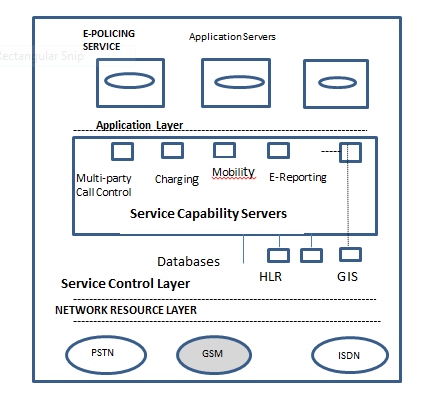 | Figure 1. Detailed overview of Open Service Architecture |
2.4.2. Intelligent Networks (IN)
The intelligence network concept: intelligence is taken out of exchanges and placed in computer nodes that are distributed throughout the network. This concept reinforces the earlier RM-ODP to gain insight on how services creation is realised through the IN conceptual model. According to (Ahamed, 2008) intelligent solution has revolutionized wireline networks and has resulted in rapid creation and deployment of services based on IN concepts. Various service capabilities are provided under capability sets such as CS-1 and CS-2. In light of our research data capability through Short Message Service (SMS) are realised as packets of data between service users. The IN conceptual model (INCM) provides a frame work for the design and description of each capability set and the target IN architecture. The INCM is structured into four planes as follows:a) Service plane (SP) – describes services and service features,b) Global function plane (GFP) – describes units of functionality known as service independent building blocks (SIBs),c) Distributed function plane (DFP) – provides network functionality known as function entities (FEs). SIBs in the GFP are realised this plane by a sequence of functional entity actions and their resulting information flow, andd) Physical plane (PP) – describes physical architecture for IN- structured network in terms of physical entities the interfaces between them hence realizing functional entities from DFP.
According to (Ahamed, 2008) intelligent solution has revolutionized wireline networks and has resulted in rapid creation and deployment of services based on IN concepts. Various service capabilities are provided under capability sets such as CS-1 and CS-2. In light of our research data capability through Short Message Service (SMS) are realised as packets of data between service users. The IN conceptual model (INCM) provides a frame work for the design and description of each capability set and the target IN architecture. The INCM is structured into four planes as follows:a) Service plane (SP) – describes services and service features,b) Global function plane (GFP) – describes units of functionality known as service independent building blocks (SIBs),c) Distributed function plane (DFP) – provides network functionality known as function entities (FEs). SIBs in the GFP are realised this plane by a sequence of functional entity actions and their resulting information flow, andd) Physical plane (PP) – describes physical architecture for IN- structured network in terms of physical entities the interfaces between them hence realizing functional entities from DFP.
2.4.3. Zambia Police Proposed Electronic Messaging System (generic e-Policing application)
The proposed e-Policing as a service architecture for e-ZP messaging system is illustrated in Figure 2, were an application is developed to quickly share information between the Police and the public in matters of public safety. It takes advantage of existing ICT/Telecommunication infrastructure, and is made easy by utilizing three underlying technologies namely mobile technology, Web technology and repository technology.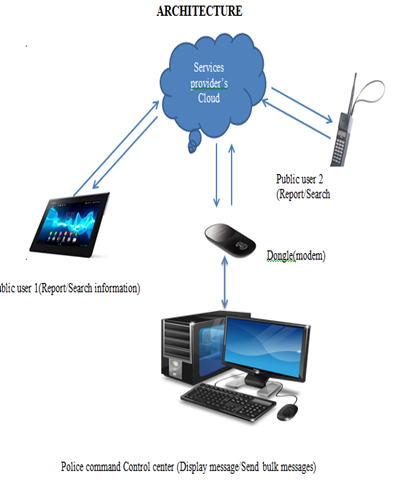 | Figure 2. E-Policing network architecture |
a) Mobile TechnologyMobile technologies are among the numerous tech innovations aimed at enhancing efficiency and effectiveness in doing business hence reducing the cost of operations. The relevance of mobile technology to Police tasks relate to timely access to accurate information, reduced administrative work for the Police Officers, improved communication and quick retrieval and transmission of relevant information (Singh and Hackney, 2011). Mobile and wireless devices, enables organization to conduct their operations more efficiently and effectively (Nah et al., 2005). These technologies are enabled through collective use of various communication infrastructure and portal battery powered devices (Rao and Troshani, 2007). The later further argued that, factors which influence successful adoption of mobile technologies include prior knowledge and experience with the technology, perceived usefulness (Lu et al., 2003), perceived ease of use (Knirtsen et al., 2005), social influence Bhattacher jee, 2000) and demographic variables such as age and gender (Nysveen et al., 2005). Further, technological characteristics such as interface and network capabilities, compatibility with existing network infrastructure, data transmission speed, availability and reliability of wireless network and information capabilities (Rao and Troshani, 2007; Sarker and wells 2003) are equally important.b) Web TechnologyThe web technology is used to receive SMS, save it to the data base and generate a response.c) Repository TechnologyThe repository technology ensures that whenever the message is received by the system a copy of that is made by storing it in the database. The system is using secure MySQL database system in providing a central storage for information sharing.
3. Materials and Methods
This research is a mix of qualitative and engineering study, where migration from manual paper based system to electronic collection, storage and information sharing is proposed for the Zambia Police. The end result is a generic e-Policing application (e-ZP Messaging System) with a centralized database for information sharing between Police and the public. Suffice to mention that, the focus area in this study was Lusaka province which included both urban and rural areas.
3.1. Materials and Computer Languages Used
In this study, materials used included software and hardware. a) Software Environment b) Hardware
b) HardwareTable 1. Hardware tool and their specification
 |
| |
|
3.2. Methodology
The methodology for the research included a qualitative analysis of data gathered from unstructured interviews (Fontana and Frey, 2005), observations (Kawalich, 2005) and focus group (Barbour, 2005) guided by initial conceptual observation from the literature. In that regard, the research method used is based on study of recent e-policing research, extensive document review, record inspection, sending of police message to stations and posts in Lusaka and the phases of Software Development Life Cycle (SDLC).
3.2.1. Study of Recent E-Policing Research
Through literature on recent e-policing study and looking at various case studies especially in developed world were ICT infrastructure is advanced and well developed, focusing on issues to consider in e-policing adoption and implementation. Further, and more close to our situation was the case of Dodoma constraint of e-policing adoption and implementation were recommendation to develop a text messaging system using mobile phone was seen to be one of the best solution in low internet penetrated areas or countries. This case study provided secondary data which gave good results and provided motivation to peruse the aspect of developing a generic e-policing application which is text based.
3.2.2. Extensive Document Review
A large amount of written materials such as the strategic plans, implementation plans, annual reports, daily incident reports, and crime statistical reports, crime reports, and stakeholder’s views on Police performance were analyzed though permission was not granted to include in this report but rather to gain insight into current policing strategies, Public perception on Police performance and challenges that confront issues on information collection, storage and information sharing.
3.2.3. Observation
Although observation provided a better understanding of challenges that confront effective information collection, storage and information sharing, focus group study with Police information rooms (Command Centers), front desk officers and patrol officers from Police stations within Lusaka, were completed to understand necessity of ICT’s in police work especially in respect to sharing of information with the Public. A copy of policing strategies, e-policing issues, performance outcomes and problems were prepared from a review of literature and presented to the group for comments. Further, Police messages were sent to nineteen Police stations in Lusaka to provide information on records of lost but found property in their custody. The purpose was to test the record management system and time of response in order to gain insight to challenges of identifying owners of such property and lastly to help identify probable solution to information sharing between police and the public. The message was sent on 27/03/2015 from Police Force Headquarters and a response was received on 08/04/2015. Out of the total number of stations only two responded representing 10.5 percent.
3.2.4. Phased Software Development Life Cycle (SDLC)
E-Policing application development is potentially complex and needs to be specified from top-down perspective (Chan et al., 2001). An object-oriented approach is better to this approach, in which the fundamental objects are first defined, and the other objects inherent from them to add more detail. This object oriented approach, decreases the overall complexity of creating the application. For the purpose of this research the scope will be limited to e-messaging for crime reporting, searching and information sharing. Designing of the system using star UML (Unified Modeling Language) and lastly is the development of the application using Java and MySQL tools. Modeling using Star UML (The Object Management, Unified Modeling Language) finds its place in RM-ODP and provides OO paradigm in helping to identify the various players and interactions involved in e-Policing and how the information will be handled by the system. The first phase of testing uses white-box testing approach on the developer side and uses black box testing (Johan J.C and R. Latuperissa, 2014) on the user side. Design stages include use of diagram provided in star UML, such as Context Diagram, Class Diagram, Use Case Diagram, and Sequence Diagram.
4. Results and Analysis
From literature on e-policing study and methodology, a business case for e-messaging system analysis, design (UML) and development is perused.
4.1. Context Diagram
The context diagram in Figure 3 illustrates systems that will interact with the e-Policing application (e-ZP messaging system).
4.1.1. Public User
The public user will send text messages to report or search for information in the Zambia Police Public data base, through public network cloud. The Police public data base will store information on reported information which is yet to be verified before storing in the crime data base. The public data base will also store information on reported missing but found property and any other information required for public communication. The public user will receive a response to indicate status of the requested information.
4.1.2. Specialized Departments
The public user can send emergency messages through the e-ZP messaging system and depending on the nature, the command control Centre will send to the relevant specialized department. If its fire, the fire Brigade will be informed accordingly.
4.1.3. Police Command Control Centre
This Centre receives reports from the public user through e-ZP messaging system display and depending on the report activates the officers in the field through Police digital radio dispatch system and other communication channels within police internal operations. The dispatch system shows location of officers and other resources such as patrol vehicles in the field. The Centre will also ensure that useful information required by the public user is sent through the e-ZP messaging system to advise or warn the public on crime related development in local areas.
4.1.4. Case Flow Management System
This is a new system being piloted in Lusaka were the work flow system from receiving and recording of the reports, dockets generation and report generation is being automated at the enquires or front desk. The system will link the police to other security wings and the judiciary. The manual system using Occurrence books were reports are recorded is now automated. Therefore, the electronic storage of reported information provides useful information for the Police in respect to both the crime data base and public data base. With this automation the public still need to physically report the cases at the front desk. This means one needs more time to walk to the nearest police station to make a report or share information with the Police.
4.1.5. Policing (e-ZP messaging system)
The e-Policing application enhances reporting of crime or searching of useful information through a centralized police data base system via text messaging. This promotes personal security and public security through virtual policing. The centralized data base system improves report generation for police planning and operations. This method further strengthens cooperation, trust and information sharing between the police and the community. 1) Emergency departments such as the Hospital, fire brigade and Drug enforcement commission.2) Forwarding and response information in crime reporting and information searching by the public users through existing ICT/Telecommunication infrastructure using text messaging system.3) Viewing of information at police command and control center.4) Information validation before entering it in police electronic capturing system for reports and docket generation. | Figure 3. E-Policing Context diagram |
4.2. Messaging System Code Structure
The system has only one html file called index html, (entry) and it has six (6) servlets. The purpose of the index is to provide the start point of the system and is used to organize navigation of the system (it gives direct access to various resources/pages).
4.2.1. MyRelay Class
It is used as a listener to all incoming messages from the SMS Enabler and it implements the appropriate responses to a request.
4.2.2. Message Format for Public to Search or Report Information to Police
To search for information or report crime with the Zambia Police, Public users can use their mobile terminals such as phones, Tablets, IPad from any Private or Public Telecommunication service providers using the format below:S – TOPIC – Detail} SearchingR – TOPIC – Detail} Register (Reporting)“S-stolen property – I’m looking for a vehicle Reg. No. ABC 122”.
4.2.3. Message Routing
The message from a mobile terminal will be received by the SMS Enabler. The Enabler will forward this message to the MyRelay. MyRelay will process the message, construct a response and forwards it to the enabler. The interaction between the SMS Enabler and MyRelay is specified in the URL of SMS Enabler in the tab called “sms to webserver”. This structure is necessary to splint function where the SMS Enabler listens to the message part for incoming messages whenever there is a message, the Enabler will read it and forwards it to the MyRelay. The purpose of the MyRelay is to process message received and construct a response which is then handed over to the Enabler, for transmission back to the sender through the public phone network.
4.2.4. Display message Servlets
The purpose of the display messages is to display information recorded in the database by the MyRelay.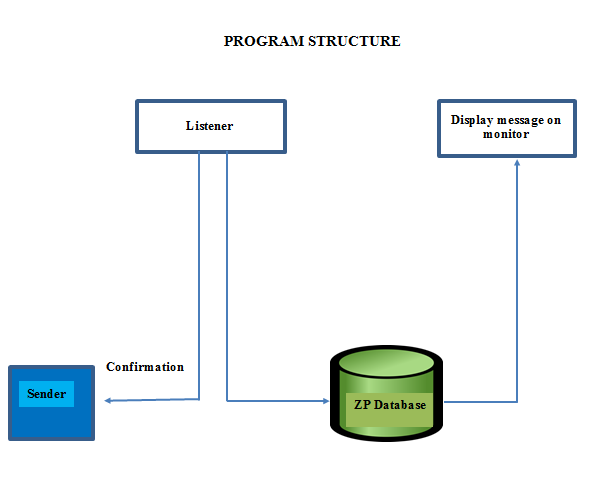 | Figure 4. Program structure |
4.3. Use Case Diagram
Use case diagram as in Figure 5, describes the relationship of the functionality applied in the application. Actors within the system are Administrator and public user.
4.3.1. Function that can be performed by Administrator
1) Send Bulk SMS message – An administrator can send a single SMS to a lot of people belonging to a particular group as specified in the system.2) View received Messages – An administrator can view SMS messages reported to the police by members of the public.3) Create Users – An administrator can create users and group them according to similarities, e.g. location, ranks, work affiliation.
4.3.2. Functions that can be performed by Public User
1) Report Crime through SMS – Any person can report a crime via SMS to the police messaging system.2) Search for information with the police via SMS – Any user can search for information of varying subject as the police offload them to the public database. This information may be missing persons, missing property like motor vehicles and national identity cards.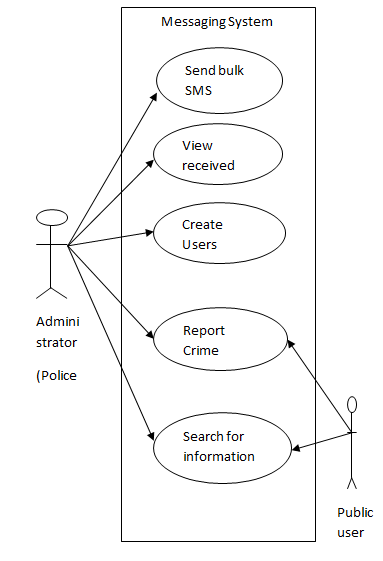 | Figure 5. e-messaging Use Case Diagram |
4.4. Sequence Diagrams
Sequence diagrams illustrates decomposition of the generic e-policing application in respect of each use case sequence of event and interfaces.
4.4.1. Report Crime through SMS Sequence Diagram (Figure 8)
1) This module listens to the message port for incoming messages, interprets the message and responds to the message as appropriate.2) A member of the public sends an SMS Message to report any crime and it is received by the computer message port.3) The message port presents such a message to the system’ message relay.4) The relay records the message in the messages table. The message table confirms saving the SMS to the Message Relay. The Message Relay sends an acknowledgement message to the message port. The message port forwards the acknowledgement to the sender.
4.4.2. Send Bulk SMS Message Sequence Diagram (Figure 6)
This is a process of sending one message to several receivers. 1) The administrator activates the SMS Manager (SendBulkMessage Class), writes a message required and the system displays the message composed.2) The administrator will select a target group from a list which is presented by the SMS Manager. The SMS Manager will then attach the selected group to the message container.3) The administrator will invoke message sending method which will present the message container to the message port. The port will give a message deliver response to the administrator.
4.4.3. View received Messages Sequence Diagram (Figure 10)
This is a used to view messages received by the system and Figure 13 illustrates sequence diagram. The administrator activates the Message Manager.1. Message Manager searches the Message Table and returns the result to itself. When this process is complete the system manager displays the message.
4.4.4. Search for information with the Police via SMS (Figure 9)
1) A member of the public sends a search key Message.2) The port receives the search key and presents it to the Message Relay.3) The relay searches the database using the received key. The message table gives up the search results to the message relay. The Message Relay sends the search result to the message port. The message port forwards the result to the inquiring number. | Figure 6. Send Bulk SMS message Sequence diagram |
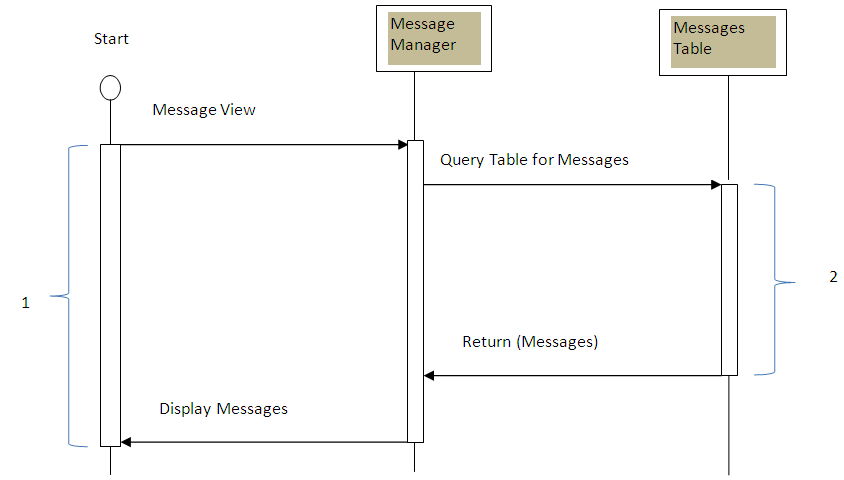 | Figure 7. View received message sequence diagram |
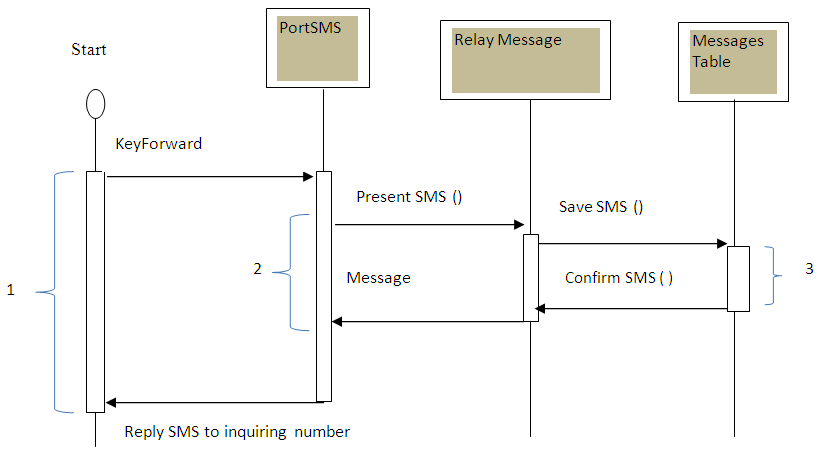 | Figure 8. Report Crime through SMS sequence diagram |
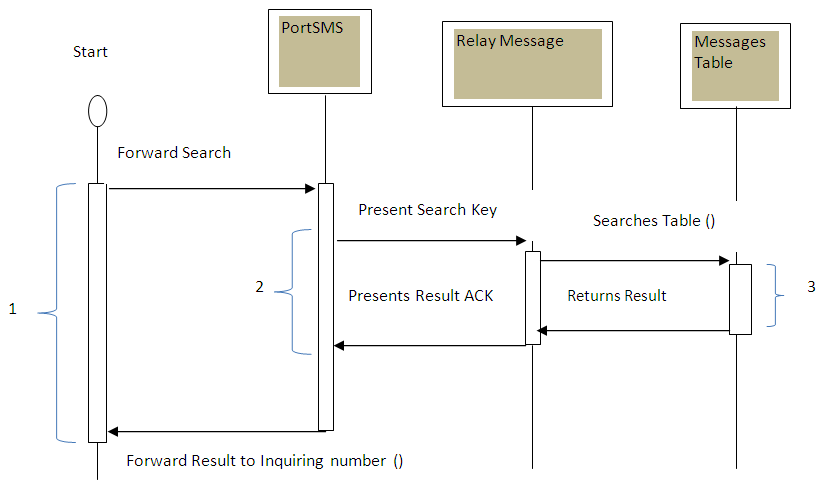 | Figure 9. Search for information with police via SMS sequence diagram |
 | Figure 10. Create Client sequence diagram |
4.5. Sample for e-ZP Messaging System
Figure 11 illustrates sample page of displayed messages as received during testing stage from mobile devices (Reporting) at police command centre. The first column represents the report number (Case number or Occurrence Book number) which is vital. The second column provides the mobile number for the reporter and the third provides the subject of the report. Further the fourth column gives details of the report and the last column provides the date and time report is received at the command center (From Public to Police).Figure 12 shows the message compose area. The user is expected to type the message in the box provided, select the target group name and click the “Send” button. This action will call the message Composer class which is responsible for retrieving phone number from the target group and forward them to the SendSMS utility. Ideally java uses Javax / JavaCOMM or RXTX independent compiled classes (not part of java / JDK) to communicate with any attached computer device like the modem or any other accessory. In implementing this there was a challenge as these classes have not been updated from the time Oracle took over java / JDK. For this reason a device communicator called SendSMS utility was developed.After the Send SMS utility has finished executing its functions, the messaging system will display a list of recipients and their phone numbers as shown below in Figure 13.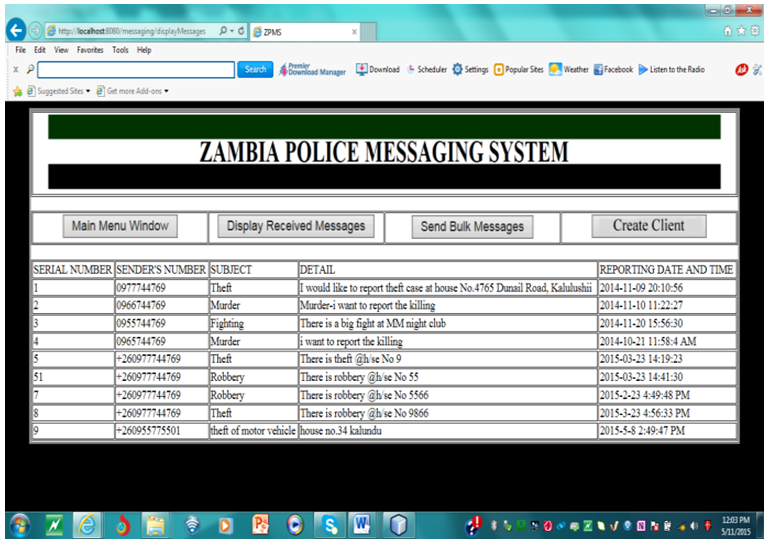 | Figure 11. Sample for e-ZP messaging Portal |
 | Figure 12. Step 2 for sending bulk message |
 | Figure 13. Final stage for sending SMS |
5. Summary of Findings and Discussion
ICT’s are important tools for enhancement of Police operation through effective electronic collection, storage and information sharing with the public. Generally, electronic services such as electronic policing require a careful balance of choice on technology diffusion, acceptance of such a process by users and a shared understanding on benefits that come with cooperation among stakeholders. Without cooperation of the Public, policing becomes very difficult to implement and at the core of this cooperation demands information and the sharing of information for effective law enforcement (Le Beuf 2003). Therefore, the tools for collecting, storing or sharing information can be manual and paper intensive or automated by electronic tools. The later provide enhanced means of information collection, storage and sharing of information, but that also come with other challenges which are underpinned by two previous research theories namely Technology Acceptance Model (TAM) and the Theory of Reasoned Action (TRA). The two theories consider behavioral intention as the central concept (Carter, L. & Belanger F. 2005). Arguably, it can be noted that, whether e-commerce, e-Health, e-Government or indeed e-Policing the issues that affect adoption and implementation of the aforementioned are also related to issues that confront electronic information collection, storage and information sharing. Since there are different policing strategies which if added result in a major challenge for Police command; and once pursued simultaneously and aggressively, the different strategies would require significant changes in the mission, objectives, technologies and basic administrative arrangement of the Police. This is where e-policing finds its vital role as part of an integrated strategic approach in electronic collection, storage and information sharing. The optimization of ICT systems to enhance information collection, storage and sharing must ensure that issues of change management as well as business re-engineering are addressed in Zambia for effective e-policing system. E-policing plays (Liu and Hu, 2005) a critical role information sharing, management and the expected benefit with implementing this concept includes:1) Improved Police to community relationship,2) Increased prevention and reduction of crime incidents,3) Enhanced Emergency service 991 applications which allow community to reduce their own risk, and enhance response from the Police or other authorities mandated to respond, and4) Allows authorities to send instant alerts to the community in matters of public safety.
6. Conclusions
In this study a Police view point for e-Policing as a service is presented and factors affecting adoption and implementation are discussed. Generally, most police services around the world have implemented e-Policing system. However, in most under developed countries like Zambia strategic adoption of this concept has been very slow with concentration on internal police modernization for improved case analysis. The key stakeholders such as the public still face challenges to contact the Police through mobile technology despite having phones and other mobiles terminals. Even, the widely used emergency lines are not localized and difficult to access due to congestion. Needless to mention that, e-Policing as a service is an extended research concept from e-Policing concepts. Ideally, this is the first attempt in research to extend the theory of e-Policing. The concept reveals that specific models within XaaS can be realised for various organisations depending on the strategic direction of an institution. However, this notion still requires further research to underpin this concept within validated model in previous research as mentioned above.This study presents a mix of qualitative and engineering research through analysis of data obtained from unstructured interviews, observations and focus group guided by initial conceptual literature review. Therefore, to enhance electronic collection and management of information, this research has developed a generic e-messaging system, where mobile users can report crime or search for information through short text messages by accessing the Police Public database (Centralized database). The Police can also send alerts and any important information to the Public via the same system. Hence, first and second specific objectives on information collection and management are realized and through application of cost effective technology, which optimizes the utilization of existing ICT’s / Telecommunication infrastructure addresses the third specific objective. Basically the system takes advantage of the increasing penetration rate of mobile technology. Accessibility to police service and other factors such a building services around citizen choices, provision for social inclusion, and making better use of information from a centralized database system the way forward in Zambia.
6.1. Recommendations
From this research study it is recommended to adopt and implement the following:a) A balance and integrated Policing strategy in policing matters through use of ICT’s,b) Deploy E-policing systems which build services around citizen choices, social inclusion and promote information sharing,c) Provides sufficient funds for training and ICT infrastructure development in the Zambia Police and other related agencies to enhance information sharing between the Police as well as the public,d) A national strategic position on Global threats must be taken into account in the adoption and implementation of e-policing,e) Implement technology which allows scalability and inter-operability with other system,f) Ensure that issues of change management and business re-engineering are looked into vis-à-vis acceptance and resistance of technology by users,g) Identify challenges that confront electronic policing service and carefully devise mitigating strategies,h) E-policing services must provide multichannel functionality in view of accessing and sharing information between the police and community, and i) Implement system with technological solution that brings efficiency and provides affordable cost to larger population.
ACKNOWLEDGEMENTS
Thanks to the University of Zambia for introducing Master’s Degree in Telecommunication Engineering and other ICT related programs under the department of Electrical and electronic Engineering. Thanks to Dr. Simon Tembo who was my supervisor on this research for his guidance. Thanks also to Mr. Sampa Nkonde for teaching us Java programing within is limited time during lectures for intelligent networks and unified communication systems respectively. Thanks to Dr. Sumbwanyambe, Dr. D. Banda, Dr. Sangayakula and Dr. B. Besa for their efforts to impact knowledge in various courses under the aforementioned program.Special thanks to my late father Dennis Njase, my mother Agnes kalutwa and my mother-in-law for encouraging me to work hard and not forgetting my wife Alice Kunda and my sons Dennis, Kunda, Joel jnr Albert and my daughter Anna for the support in my pursuit of this study tour. Last but not least, I owe my greatest thanks to the Almighty God.
References
| [1] | A. Fotana and J.H Frey, 2005. The interview:From neutral stance to political involvement. In N.K Denzin and Y.S Lincoln, The sage Handbook of Qualitative research 3rd ed. |
| [2] | Ashby, D.I and P.A Longley, 2005. “Geocomputation, geodemographic and resource allocation of local policing”, Transaction in GIS, Vol.9 No. 1, pp.53-72. |
| [3] | Barbara B. kawachich, 2005. Participant observation as data Collection method. Forum: Qualitative Social research 6(2), Art 43. |
| [4] | Boondao, R. and N.K Tripathi, 2007. "Electronic Policing:A Framrwork for Crime Control and Citizen Services". In Social Implication and challenges of E-Business Edited by Feng Li.LGI global.pp 78-93 (n.d.). |
| [5] | Burtylev et al., 2013. Development of Electronic Document Management Systems: Advantages and Efficiency. Special issue: 1-9, DOI;10.5923/s.scit.201301.01 by Science & Academic Publishing under science and Techology of march 2013. |
| [6] | College of Policing, 2015. Engagement (Internet) |
| [7] | Dr.UM (Samsung of south Korea), 2010. Feasibility study on Emergency Management Information System (EMIS) for Ministry of Home Affairs of the republic of Zambia (2010). |
| [8] | Esther Ruiz Ben and Tino Schuppan 2014. E-Government Innovations and Transformations: Implication of introduction of Electronic tools in Public Government Organisations. |
| [9] | http://www.csis.pace.edu/lixin.Introduction to Web technologies, Accessed on 20/05/2015 http: // www. Strategic growth concepts.com/growth/incaccessed 229/09/2015. |
| [10] | Golara khayltash and Hu Hanrahan, 2006. Emergency services: The Way Forward . |
| [11] | Ismail M. Romi, 2014. Information Reach and Range impact on Inter-organization Systems Platforms. |
| [12] | Janet Chan, David Brereton, Margot Legosz, Sally Doran, 2001. The Impact of Information on Police practices (Accssible on www.cjc.qld.gov.au). |
| [13] | Kecheng Liu and Michael Hu, 2005. Semiotic Analysis of E-Policing strategies in the United Kingdom. |
| [14] | Koper, C.S. Taylaor, B.G and B.E Kubu, 2009" Law Enforcement Technology Needs Assessment; Future Technologies to Address the Operational Needs of Law Enforcement". A reort submitted to PoliceExecutive Research Forum and Lockheed Martin Foundation. |
| [15] | Lazaro S.P Busagala and Lilian Jacob Ringo, 2013. Constraints of E-Policing Adoption, A case of Dodoma, Tanzania (Volume 3 No.1 January 2013.). |
| [16] | Marcel-Eugene LeBeuf, PhD, 2006. E-Policing in Police Services-Definitions, Issues and current Experiences (http://www.rcmp-grc.gc.ca) . |
| [17] | Marcel-Eugene LeBeuf, PhD, 2005. Information Sharing amoung Canadian Police departments: Trusting Individuals or Systems. |
| [18] | Marchionini, G., H. Samet and L. Brandt, 2003. Digital government.comm.ofthe ACM, 25-27. (n.d.). |
| [19] | Mark H. Moore and C.Robert, 1988. Strategies for Policing (http://www.ncjrs.gov;Corporate/Trojanowicz,1988 (visited 03/04/2015.). |
| [20] | Mark Perlman, 2012. "Using Technology to Enhance Communities’ Engagement with the Public Safety (2012). |
| [21] | Matthew, A. J. and M. C. de Guzman, 2011. E-Policing, The value of Police Websites for citizen empowered participation. |
| [22] | Matthew A Jones and Melchor C. de Guzman, 2012. E-policing: Environmental and Organizational correlates of website features and characteristics Among Large departments in the United states of America, (http://www.igi.global.com,visited 25/03/2015). |
| [23] | Min Yin and Sheng Liu, 2014. Comparative study of traditional Network Marketing and E-Commerce Marketing based on cloud computing. |
| [24] | Pacific Council on International Policy, 2002. |
| [25] | R.S Barbour, 2005."Making sense of focus groups". Medical eduction 39(7), 742-750. |
| [26] | Singh Mohini and Hackney Ray, 2011. "Mobile Technologies for Public Police Force tasks and processes: At Government Perspective". ECIS 2011 proceeding's, Paper 82. http:llaisel. aisnet. Org/ecis 2011/82. |
| [27] | United Nations Office on Drugs and Crime, 2006. Public Safety and Police Service Delivery. |
| [28] | United Nations Office for Drug and Crime, 2006. Policing- police Information and intelligent systems, Criminal Justice Assessment Toolkit (n.d.). |
| [29] | United Nations Office for Drug and Crime, 2011. Introductory Handbook on Policing Urban Space (http://www.unhabitat.org). |
| [30] | www. trading economics. Com (visited 15/03/2015). |
| [31] | www. Unicef. Org; visited 15/03/2015 (n.d.). |
| [32] | Zambia Police strategic plan (2013-2016). |




 According to (Ahamed, 2008) intelligent solution has revolutionized wireline networks and has resulted in rapid creation and deployment of services based on IN concepts. Various service capabilities are provided under capability sets such as CS-1 and CS-2. In light of our research data capability through Short Message Service (SMS) are realised as packets of data between service users. The IN conceptual model (INCM) provides a frame work for the design and description of each capability set and the target IN architecture. The INCM is structured into four planes as follows:a) Service plane (SP) – describes services and service features,b) Global function plane (GFP) – describes units of functionality known as service independent building blocks (SIBs),c) Distributed function plane (DFP) – provides network functionality known as function entities (FEs). SIBs in the GFP are realised this plane by a sequence of functional entity actions and their resulting information flow, andd) Physical plane (PP) – describes physical architecture for IN- structured network in terms of physical entities the interfaces between them hence realizing functional entities from DFP.
According to (Ahamed, 2008) intelligent solution has revolutionized wireline networks and has resulted in rapid creation and deployment of services based on IN concepts. Various service capabilities are provided under capability sets such as CS-1 and CS-2. In light of our research data capability through Short Message Service (SMS) are realised as packets of data between service users. The IN conceptual model (INCM) provides a frame work for the design and description of each capability set and the target IN architecture. The INCM is structured into four planes as follows:a) Service plane (SP) – describes services and service features,b) Global function plane (GFP) – describes units of functionality known as service independent building blocks (SIBs),c) Distributed function plane (DFP) – provides network functionality known as function entities (FEs). SIBs in the GFP are realised this plane by a sequence of functional entity actions and their resulting information flow, andd) Physical plane (PP) – describes physical architecture for IN- structured network in terms of physical entities the interfaces between them hence realizing functional entities from DFP.
 b) Hardware
b) Hardware










 Abstract
Abstract Reference
Reference Full-Text PDF
Full-Text PDF Full-text HTML
Full-text HTML